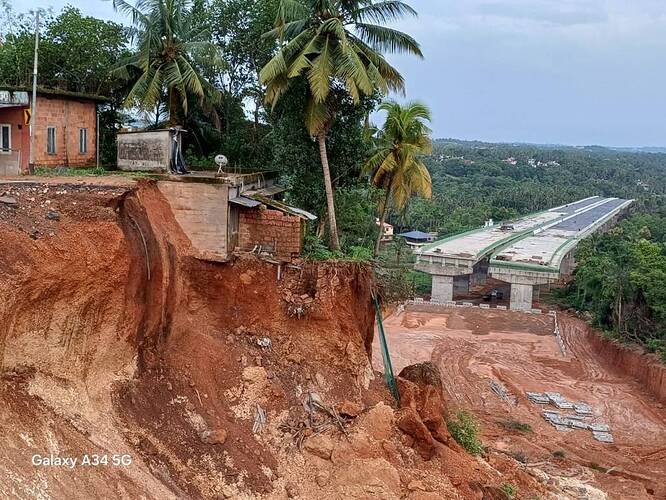In a lengthy expose, the South Asia Network for Dams, Rivers and People published a study by environmental engineer-activist Sridhar Radhakrishnan, describing how, bypassing systems set up specifically to ensure adequacy of engineering and social planning, the cross country highway that has been renumbered NH66, is creating havoc in Kerala.
“In the mid-2010s, NH66 was chosen for six-laning under the Bharatmala Pariyojana as part of India’s national corridor development program. The 644-km Kerala stretch — from Thalappady to Mukkola —was deliberately sliced into segments under 100 km to bypass full environmental impact assessments . The move allowed the NHAI to avoid public hearings, hydrological and ecological studies, and social audits, which are essential steps for large linear infrastructure.
…
Our warnings — about blocking hydrological flow and destroying midland hills for soil — were ignored. We were mocked by the officials and contractors and even told we were “anti-development.”
…
Environmentalists and social and cultural leaders from across Kerala supported the protest. The Kerala Shastra Sahitya Parishad proposed alternatives like realignment or a viaduct, all of which were contemptuously ignored. Instead, NHAI, backed by the Kerala PWD and state government, pushed the original alignment. To source soil, nearby laterite hillocks were razed, destroying natural catchments and worsening the water crisis.
…
The protest was vilified as “anti-development.” The ruling party in Kerala, led by the Chief Minister and District party leaders, invoked the narrative of progress to delegitimise the dissent and target village leaders. Protesters were evicted, arrested, and falsely charged. Despite proclaiming their concern for ecology and the threat of floods after 2018, the state government retracted, and became agents of destruction .”
…
NH66, by contrast (to the cancelled Silverline rail expressway project) slipped through. Built in fragments, tendered without public scrutiny, and justified with national templates, it faced no state-wide hearings or cumulative EIA. Each district or community saw only a small part of the project—never the complete picture. In contrast, unlike SilverLine, NH66 had bipartisan political backing as a symbol of development. Even local resistance—like Keezhattoor—was isolated and suppressed.
NH66 in Kerala: Built Against Water Logic, Designed to Collapse?
It wasn’t easy writing this — because it tells of injustice done to Kerala’s people, waters, and land.
NH66 was meant to be a lifeline. Now, it’s collapsing — built against water, land, people, and every warning. This isn’t just a failed highway. It’s a disaster by design.
Yes, the article is long — but so is the damage we now face. If you truly want to know what went wrong, and why it matters now, please read it fully.
